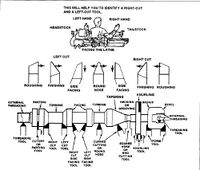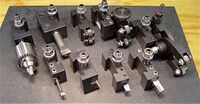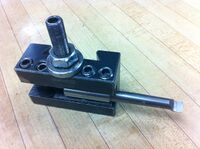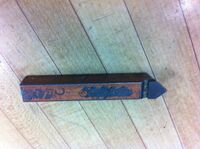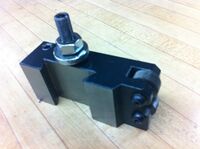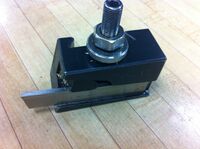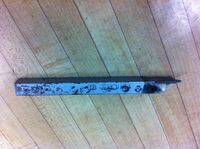Cutter Types (Lathe)
Overview
| Tool/Step | Description |
|---|---|
| Identifying tools[1] | |
| Cutter classification
Numbers 1, and 2 are Left and right-hand side-tools. Numbers 3 and 7 are Bent and straight cut-off tools. Numbers 4 and 5 are Right and left-hand diamond points. Number 6 is a Fillet or round-nose tool. Number 8 is a Threading tool. Number 9 is a Bent threading tool. Number 10 is a Roughing tool. Number 11 is an Inside boring tool. Number 12 is an Inside threading tool. | |
| Tooling from left to right, top row: a drill chuck, boring bar, knurling tool, and two scissors-type knurlers.
Tooling from Left to right, bottom row: small boring bar, a cutoff blade, and two facing tools. [3] | |
| This shows some fo the different shapes and styles of tooling.[4] |
Common Lathe Cutting Tool Types
| Tool/Step | Description |
|---|---|
| This tool should be used if you need to shorten the length of your stock or make the diameter smaller. Its main function is to face the stock so you have a nice smooth surface to work with. | |
| This tool should be used if you need to make a hole in the stock bigger in diameter. Before using this tool, there must already be a hole in the stock. | |
| This tool should be used if you need to make a chamfer on the edge of a stock. Or to break an edge. | |
| This tool should be used if you need to put a knurling on your stock. This is normally used on knobs where better grip is needed. | |
| This tool should be used if you need to cut some of the stock off to shorten it. | |
| This tool should be used if you need to cut a channel into the stock. Such as O-ring groves or any other small depth groove. |
Tool Speeds
There is a chart outside of the Machine Shop Office that shows tooling and material speeds. Pay close attention to this whenever working with the Lathe. If you are unsure what material the tool is made out of be sure to ask, for the most part, if the tool is shiny it is made from High Speed Steel, and if the tool has a dull and greyish finish, it is made from or plated with Carbide.
| Tool/Step | Description |
|---|---|
| As shown, the speed increase as the material becomes softer.[5] | |
| As shown, the speed increases as the tooling material becomes stronger.[6] |
References
- ↑ http://www.mechlook.com/wp-content/uploads/2009/08/Machine_Machine-Tool_Lathe_Tool-bit-shapes.jpg
- ↑ http://chestofbooks.com/crafts/mechanics/Mechanical-Processes/320-Lathe-Tools.html#.UaZ0IPPn-M8
- ↑ : http://www.micro-machine-shop.com/quick_change_tool_post_tool_bits.htm
- ↑ http://www.micro-machine-shop.com/lathe_tools_std_shapes.jpg
- ↑ http://its.fvtc.edu/machshop2/speeds/rpmcalc.htm
- ↑ http://its.fvtc.edu/machshop2/speeds/rpmcalc.htm
